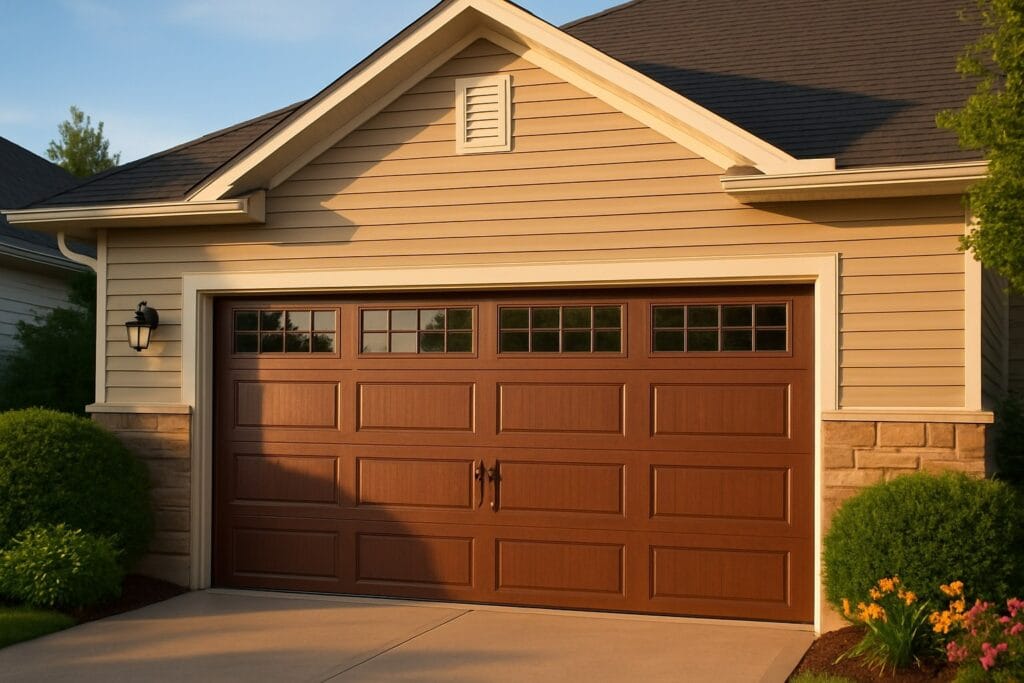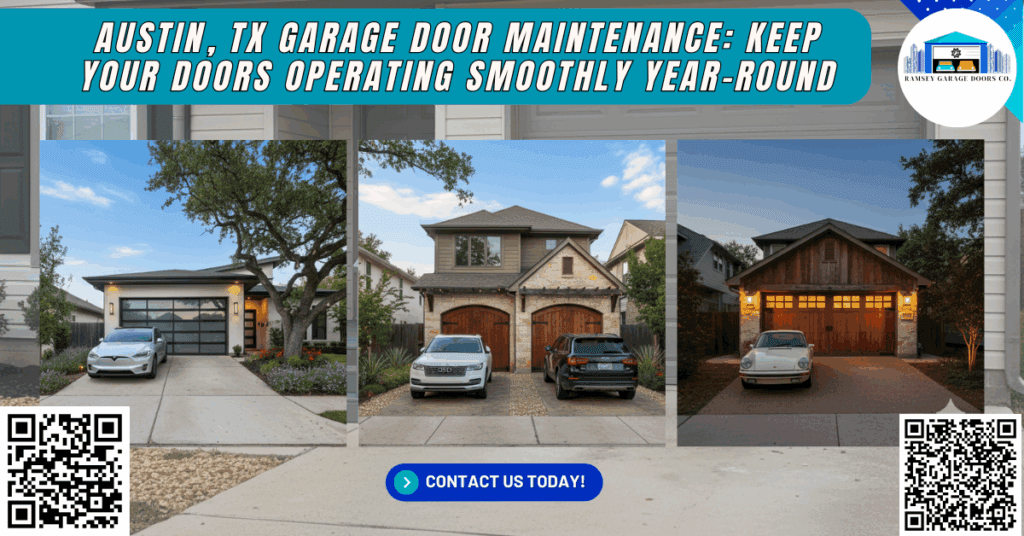A few months ago, a homeowner from North Austin contacted Ramsey Garage Doors Co. after her garage door froze halfway while closing. The issue seemed simple at first, but a closer inspection revealed dry rollers, misaligned tracks, and a worn-out spring that hadn’t been serviced in over five years. What could have been a minor tune-up turned into a costly repair and replacement of several parts. This situation highlights a common problem many homeowners face, neglecting Garage Door Maintenance until serious issues arise.
Did you know that the average garage door opens and closes over 1,500 times per year? In Austin’s climate, where humidity, dust, and fluctuating temperatures can quickly wear down metal components, a consistent maintenance schedule is the key to smooth operation. Whether you have a standard sectional door, a custom wooden model, or a commercial overhead system, regular garage door maintenance ensures your entire system functions safely, efficiently, and quietly year-round.
At Ramsey Garage Doors Co., we’ve spent years helping local homeowners and businesses prevent costly repairs through reliable preventative maintenance. From routine inspections to professional lubrication, our goal is to protect your garage door investment and ensure safe, dependable performance for many years to come.
Why Garage Door Maintenance Matters
A garage door is one of the largest and most frequently used moving components in your home. It operates under significant tension and relies on a combination of mechanical and electrical parts, including springs, rollers, tracks, and sensors, all of which must work in perfect synchronization. Without routine attention, even minor wear or debris buildup can lead to malfunctions that compromise both convenience and safety.
Consistent door maintenance helps to:
- Prevent Costly Repairs: Routine lubrication, cleaning, and inspections can prevent serious issues like broken springs or damaged openers.
- Ensure Safety: A well-maintained system minimizes risks associated with sudden failures, such as spring snapping or a cable detachment, which could lead to property damage or injury.
- Improve Longevity: With proper care, your garage door system can last up to two decades or more before needing replacement.
- Enhance Energy Efficiency: Regular upkeep of weather stripping and seals helps maintain indoor temperatures and reduces energy loss.
- Preserve Curb Appeal: A clean, properly aligned door not only performs better but also enhances the appearance of your home.

Every part of your garage door, from the smallest hinge to the heaviest panel, benefits from regular inspection and professional service.
Key Components of a Garage Door System
To keep your garage door in good condition, it helps to understand how the main components work together. Each part plays a crucial role in smooth operation and overall system balance.
- Torsion Springs: These tightly wound coils counterbalance the door’s weight. Over time, they lose tension and may eventually break if not inspected regularly.
- Cables: Cables lift and lower the door safely. Frayed or loose cables are a common sign that the system needs professional attention.
- Rollers: The garage door rollers help the door glide along the track. Dirt, rust, or worn bearings can cause jerky motion or loud squeaks.
- Tracks: These metal rails guide the door as it moves. Bends, dents, or debris buildup can cause the door to jam or become misaligned.
- Hinges and Hardware: Hinges allow the panels to bend while opening. Loose nuts, bolts, or rusted hinges can compromise door movement.
- Garage Door Opener: The opener is the system’s motorized heart. It should operate quietly and reliably with functional auto-reverse sensors for safety.
- Weather Stripping: This rubber or vinyl material seals the gaps, protecting your garage from drafts, pests, and moisture.
Regular inspections of these parts help prevent common garage door issues such as imbalance, loud noises, and sudden failure.
Common Garage Door Problems in Austin, TX
Austin’s climate is beautiful but challenging for metal and mechanical systems. The combination of heat, humidity, and seasonal rain can accelerate wear and corrosion.
1. Heat and Humidity
Prolonged exposure to high temperatures can cause metal expansion, affecting alignment and door operation. Moisture can also promote rust and corrosion on springs, hinges, and hardware.
2. Dust and Pollen
Central Texas dust, combined with seasonal pollen, can clog garage door tracks and interfere with sensors, leading to unreliable operation.
3. Storm Damage
Sudden storms or lightning surges can damage garage door openers, control boards, and electrical circuits.
4. Lack of Lubrication
Without regular spray lubricant, parts like rollers, springs, and hinges begin to grind, resulting in noisy, uneven movement.
Recognizing these potential issues early allows for timely maintenance and prevents emergency repairs that can cost significantly more.
Seasonal Garage Door Maintenance in Austin, TX
Because Austin experiences warm summers and mild winters, seasonal maintenance ensures your garage door system adapts to changing weather conditions.
Spring and Summer Maintenance
- Clean and lubricate all metal parts to combat heat-induced friction.
- Inspect for rust or corrosion on springs and tracks.
- Test auto-reverse sensors to ensure safe operation.
- Check the weather stripping for cracks caused by heat exposure.
Fall and Winter Maintenance
- Tighten bolts and brackets loosened by temperature fluctuations.
- Check insulation and seals for air leaks to improve energy efficiency.
- Clear away leaves, dirt, or debris near the bottom seal.
- Inspect garage door openers and replace backup batteries if necessary.
Performing these maintenance tasks regularly helps you avoid sudden breakdowns and keeps your garage door running smoothly no matter the season.
Step-by-Step Garage Door Maintenance Guide
Here’s a practical guide to help homeowners perform basic garage door maintenance at home. Always exercise caution and contact professionals for high-tension parts like springs or cables.
1. Perform a Visual Inspection
Examine every component of your garage door system — rollers, hinges, tracks, and cables. Look for frayed lines, rust, dents, or loose hardware.
2. Lubricate Moving Parts
Use a spray lubricant on rollers, hinges, springs, and pulleys. Avoid grease that attracts dust. A few drops on each moving part can make a big difference in smooth operation.
3. Clean the Tracks
Wipe the tracks using a microfiber cloth and degreaser to remove dirt and buildup. Clean tracks allow for quiet, even door movement.
4. Tighten Hardware
Over time, vibration loosens bolts and screws. Use a wrench to secure nuts, bolts, and brackets along the track and hinges.
5. Test Door Balance
Disconnect the opener and manually lift the door halfway. If it stays in place, it’s balanced. If it moves up or down, tension springs may need adjustment — a task for professionals.
6. Test Safety Features
Check the auto-reverse sensors by placing an object under the door. If the door doesn’t reverse upon contact, schedule immediate service.
7. Clean and Replace Weather Stripping
Remove old, cracked weather seals and replace them with new ones. This prevents water, pests, and dust from entering the garage while improving energy efficiency.
8. Examine the Opener
Check remote batteries and test the opener’s response time. Listen for unusual noises that could indicate motor or gear wear.
Professional vs. DIY Maintenance
While basic garage door maintenance can be handled by most homeowners, some repairs require expert care. Professional technicians from Ramsey Garage Doors Co. have the tools and experience to manage complex systems safely.
DIY Maintenance Tasks Include:
- Cleaning tracks and panels
- Lubricating rollers and hinges
- Testing door balance and sensors
- Inspecting weather seals
Professional Maintenance Includes:
- Adjusting or replacing garage door springs
- Realigning tracks
- Replacing worn-out rollers or cables
- Comprehensive system diagnostics
Attempting high-tension work without training can cause serious injury. Professional service ensures your garage door remains safe, compliant, and reliable.
How Often Should You Schedule Maintenance?
The frequency of garage door inspections depends on how often the door is used. On average, homeowners should schedule a professional inspection once per year, while commercial properties or high-use doors may require service every six months.
Recommended schedule:
- Residential Garage Doors: Once annually
- Commercial Garage Doors: Twice a year
- High-Use or Dusty Areas: Every 3–4 months
Consistent, regular maintenance saves both time and money by preventing breakdowns and prolonging the life of your entire system.
Signs You Need Immediate Maintenance
Certain warning signs suggest it’s time to call a professional:
- Loud grinding, squealing, or rattling noises
- Uneven door movement or sagging panels
- Door reverses unexpectedly
- Opener fails to respond or operates intermittently
- Frayed cables or visible rust on springs
- Gaps under the door despite being closed

Addressing these problems early prevents costly repairs and reduces safety risks.
Maintenance for Commercial Garage Doors
In Austin, commercial buildings rely on robust garage door systems that often operate hundreds of times each week. These doors require stricter attention and specialized preventative maintenance plans.
Professional technicians focus on:
- Checking high-cycle tension springs
- Inspecting industrial door openers
- Replacing worn rollers and cables
- Testing fire-rated and security systems
For business owners, preventative maintenance minimizes downtime, enhances safety compliance, and ensures reliable daily operations.
Energy Efficiency and Weatherproofing Tips
Austin’s hot climate makes energy efficiency a top priority for homeowners. A poorly sealed garage door can allow heat, humidity, and dust to infiltrate your home. Simple upgrades can improve insulation and lower cooling costs.
Tips for better energy efficiency:
- Replace old or cracked weatherstripping
- Add insulation to steel or wooden panels
- Seal gaps around the frame with caulking
- Keep door surfaces clean to prevent material degradation
Maintaining tight seals not only improves comfort but also enhances your home’s overall energy performance and curb appeal.
Preventive Maintenance Checklist
Keep this garage door maintenance checklist handy for routine care:
- Lubricate rollers, hinges, and springs with spray lubricant
- Wipe down tracks using a microfiber cloth and degreaser
- Tighten all bolts, nuts, and brackets
- Test safety sensors and opener operation
- Clean and inspect weather stripping
- Check for signs of rust or corrosion
- Listen for abnormal noises during operation
- Schedule annual professional inspection
Regularly following this checklist ensures your garage door stays in excellent condition and prevents potential issues before they escalate.
How Can Ramsey Garage Doors Co. Help You?
At Ramsey Garage Doors Co., we specialize in comprehensive garage door maintenance, repair, and installation services throughout Austin, TX, and surrounding communities. Whether you need a quick tune-up, a complete system inspection, or emergency repairs, our team of expert technicians is ready to help.
Located at 5502 Burnet Rd, Austin, TX 78756, our local team provides personalized care and timely solutions designed for Austin’s unique weather conditions. We handle everything from broken springs and malfunctioning openers to weather stripping replacements and new garage door installations.
When you choose Ramsey Garage Doors Co., you get:
- Prompt service from trained technicians
- Full system inspections and safety testing
- Honest pricing with no hidden costs
- High-quality replacement parts for long-lasting performance
- Expert advice on preventative maintenance and upgrades
If your garage door is making unusual noises, struggling to close, or showing signs of wear, don’t wait for a complete breakdown. Call (512) 675-6884 today to schedule your professional garage door maintenance service and experience the reliability that Austin homeowners trust year after year.
Final Thoughts
Your garage door plays an essential role in protecting your home, improving energy efficiency, and ensuring everyday convenience. Like any mechanical system, it requires consistent maintenance and occasional professional attention to operate safely and reliably. By performing simple tasks like cleaning, lubrication, and visual inspections, and partnering with experts for more complex repairs, you can prevent costly repairs, extend the life of your garage door system, and maintain the beauty and functionality of your home for years to come.
Many homeowners overlook garage door upkeep until problems arise, but with a proactive approach, you can avoid emergencies, enhance safety, and keep your garage door performing at its best all year long. Whether it’s tightening a few bolts, checking the weather stripping, or scheduling a professional tune-up, every small step contributes to a longer-lasting, more efficient system.
If you are ready to safeguard your investment and enjoy smooth, quiet operation, reach out to Ramsey Garage Doors Co. for dependable, professional care. With decades of experience and a reputation for excellence, our team is here to help you achieve lasting peace of mind, one garage door maintenance visit at a time.
Frequently Asked Questions (FAQs)
1. How long does a typical garage door maintenance appointment take?
A standard garage door maintenance service usually takes about 45 minutes to an hour. However, if the technician finds issues that require adjustments or part replacements, the visit may extend slightly to ensure the entire system is operating correctly.
2. Can I use WD-40 to lubricate my garage door parts?
It’s best to avoid using WD-40 for lubrication because it is a cleaner and degreaser, not a true lubricant. Instead, use a silicone-based or lithium spray lubricant specifically designed for garage door components to ensure long-lasting smooth operation.
3. How can I tell if my garage door spring is about to break?
You may notice your door opening unevenly, making loud popping or squeaking noises, or feeling heavier than usual when lifting manually. These are early warning signs that the spring is weakening and should be inspected by a professional before it breaks completely.
4. What type of weather stripping works best for Austin’s climate?
For Austin’s hot and humid conditions, a high-quality vinyl or rubber weather stripping works best. These materials provide flexibility and durability, helping to keep out moisture, dust, and hot air while improving your garage’s energy efficiency year-round.

